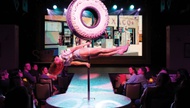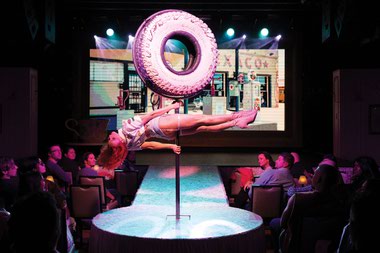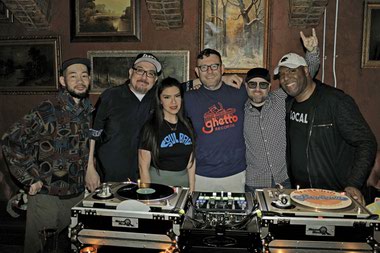Bottle service killed Vegas nightlife. Or so it may seem to the average club-goer on a Saturday night.
Everyone craves the privilege of going beyond the velvet rope; hence clubs have been in a prime position to rake in the dough. For the last seven or eight years, ballers and high rollers inside megaclubs have been sitting on prime real estate, drinking champagne and waving sparklers. Meanwhile, the everyman, with his 9-to-5 job, remained outside, visions of dancing his crappy week away fading because of his inability to spring for an entire bottle of Grey Goose. He was banished instead to the land of interminable general-admission lines.
But something changed this year. Ballers are beginning to check their bank accounts, and the everyman is digging for change in the sofa cushions to buy Ramen.
Okay, it may not be that bad (yet), but denying the economic decline is no longer possible. Our days of frivolous hard partying may be over, and we’re reconsidering that fourth $15 cocktail for reasons other than seeing double. How did we get here? If we don’t figure it out, the future of Las Vegas nightlife could be in grave danger.
Once upon a time, nightclubs weren’t inside casinos …
“At the very beginning, [nightclubs were] kind of a side business for Vegas,” says Michael Fuller, vice president of the N9NE Group and an industry vet of more than 15 years. “It gave people something to do at nighttime, and there wasn’t a lot of casino clubs really invested in the way that they are now.” He adds, “Now if you open a casino, you have to have a nightclub in it. It’s one of the top industries for Las Vegas.”
Privé owner Justin Levine believes having a nightclub outside of a casino has become difficult to sustain. “Tourists prefer to stay on the Strip, being that there are so many amazing restaurants, gaming and shopping options under one roof.”
“As time has gone by, there are many new venues inside of hotels on the Strip that are very successful,” says Jordan Miner, director of promotions for Tao, Tao Beach and Lavo. “Most of the action in Vegas is on the Strip, and that has led to the amount of nightclubs and new venues coming soon in hotels.” Miner adds that he still sees a successful freestanding nightclub being plausible in the future.
Fuller blames a lack of fixed traffic for the challenge of sustaining a grossly successful venture outside of a casino. “We tried to do Ice there for several years, and even though I felt we were all great operators doing a great job and dedicated to the project, it still was close to impossible.” Fuller believes the freestanding club no longer makes sense, because it’ll have to compete against the casino clubs that are now getting the locals as well as the tourists. Brian Klimaski of Angel Management Group cites the walk-up traffic in the hotel-casinos as an important factor in creating a successful night for a club. “You have an opportunity to have more fillers,” he says.
Vegas Alliance CEO Gino LoPinto sees pros and cons to the evolution of casino partnerships. “The good is the budgets and the quality of the party. The money behind DJs and hosts and celebrity guests and so forth has definitely made it a little more upscale,” he says. “On the negative side, I definitely think it’s lost a lot as far as vibe [of the] party, which is why I’ve stayed with afterhours so long.”
Nevertheless, when it comes to the average club-goer’s experience, not everyone sees the nightclub/casino partnerships as a plus. “The nightclub scene—to me—has kind of suffered the Walmart syndrome,” says industry veteran Tony Verdugo, “in that the casinos own and operate every single club. What I’m talking about is there’s no more old-school Vegas-type clubs where you’re greeted with a hug and a smile and your first name.” Verdugo worries the megaclubs as of late only care about bottle minimums and whether or not patrons have a Black AmEx card.
It’s good to be on top … or, “Where my fillers at?”
“Fillers” are the average folks, the ones who wait patiently in the general-admission line, eager to get sweaty on the dance floor. Fillers are necessary to give the Very Important Person a group to feel, well … very important over. “It’s a symbiotic relationship: the bottle-buyer and the mass audience,” says Fuller. “What if the bottle-buyer came in and there was no one for him to feel like he was on top of someone else?” He explains that the ideal crowd consists of a trinity: the fillers, the people with money and the core club-culture crowd. “They all work off of each other.”
We know the economy isn’t looking so stellar these days, and even the aforementioned “people with money” are lately ballin’ on a budget. Coupled with recent events on Wall Street, everyone from the bottle-buyer on down appears a bit more hesitant to party. But it also means that prime real estate is now up for grabs.
Judging by the behaviors of some clubs, such as an increased number of deals to entice patrons, it looks as if the seller’s market of the past half-decade is done, and a buyer’s market is emerging. “As the economy continues to decline, people can’t afford to spend $500 on a bottle of Grey Goose when they know that bottle only costs $30 at Costco,” says Verdugo. With the exception of a couple of major players in the nightclub game (Pure Management Group and Light Group were the only entities the Weekly contacted that declined to be interviewed), the majority of the industry acknowledges the shift and is willing to talk about what they’re doing to keep the party going.
Klimaski believes the economy has definitely affected the nightclub industry in recent months. “You find fewer people going out as much,” he says. “More than ever, my phone has blown up with comp-bottle texts every day now.” Klimaski adds that clubs are trying to give back to the patrons to garner support and venue loyalty.
However, Anthony Olheiser, director of nightlife at the MGM Grand, says they haven’t had to change much at this point. “The numbers are still very, very good.” He cites the success of the Late Night afterhours at Tabu and notes the popularity of the event has it moving to Studio 54 this month. Conversely, LoPinto says, “I see the same amount of people coming through the door, but spending a little less now that the economy’s down.”
“The hotels might be down a little bit, the restaurants might be down a little bit, and the numbers might be down a little bit in the nightclubs as well, but it hasn’t really hit as bad as it’s hit in other places,” says Ethan Asch, managing partner of the new Rok Vegas inside New York-New York. “I think people still come to Las Vegas to party, and I think that’s the one thing we have on our side. They come to Vegas, they still want to drink. They may get a cheaper room, and they may not gamble as much … but I’m telling you, they’re going to the clubs.”
“It seems like anytime there’s a shake-up with the economy or anything like that, it almost seems like the clubs and the nightlife are the last thing to be affected,” says Olheiser.
Yet, in recent weeks, there’s been a bit more elbow room on a few of the dance floors. While that’s a negative for the clubs, it could be advantageous for the Average Joe who still has a regular paycheck and a propensity for partying. “It’s going back the other way right now. Definitely more about the general patrons, general admission, passes, wristbands,” says LoPinto. “Very rarely are you going to see a five-, six-bottle minimum anymore right now.” He adds, “Now I think [clubs] will start going to table minimums.” We have seen this to be the case already with the opening of Christian Audigier.
LoPinto mentions he’s also noticed more buy-one, get-one bottle deals on industry nights. “It’s just the nature of the beast,” he says of discounts. “We’re not a foolproof business. There’s nobody in town—not the best of them—that aren’t feeling a little bit of the economy pressure.”
“Naturally, everyone is feeling the pinch of the economy,” says Levine. “We are fortunate that [Privé] happens to be a smaller club and doesn’t need as many patrons to keep the club busy and successful. It’s harder for venues that are, say, 40,000 square feet with multiple rooms. Chances are you are not opening all your rooms and seeing a lot less traffic than you once did.”
Fuller believes maintaining a core local following will be the key to success. “We’re in a very crazy situation right now with the way the economy is nationally and globally and whatnot,” he says. “If we don’t give value, then we’ll never have brand loyalty from the customers.”
V is for value—a peek into the crystal ball
“You can’t make money off of everybody, and you really shouldn’t,” says Fuller. “We’re now seeing it come off of that plateau … and not just be about bottle service, but also giving people more value.” He adds, “Everything’s about value right now,” and cites the “bounce-around pass” at the Palms as one example. “Let’s say you go into one of our clubs on a certain night,” Fuller says. “As long as you’re not hammered and belligerent and you walk out, we will try to get you to bounce into another one for free depending on what time it is and what day it is. It’s giving back.”
Levine believes the accessibility of Privé’s layout appeals to general-admission club-goers and that not having roped-off sections helps his venue. “People don’t want to leave a nightclub with three wristbands and a row of stamps up their arm that tells them where they can and can’t go. It doesn’t make for a fun evening,” says Levine.
For those craving a departure from the Strip, Puff Lounge, with its primarily local crowd, has implemented a different bottle-service option. “What we do is we package three [smaller bottles] together,” says Abdi Nasr, co-owner of Puff. “So you can have, say, a 375-milliliter bottle of Patron, and one of Goose and say one of Jaeger.” Rok Vegas has also embraced the smaller-bottle alternative. “If not everyone’s drinking vodka, you can get a half-bottle of Jack Daniel’s,” says Asch. “That’s been very successful.”
“I think we’re going to go along with the economy, just like real estate and everything else,” says LoPinto. He predicts Las Vegas nightlife will eventually come back bigger and stronger than before. Multiple venues supporting one another also helps nightclubs maintain a following. “It’s very interesting how the industry has evolved,” says Klimaski. “A lot of people are working together, more so than I’ve ever seen before—a lot of the hosts especially.” He adds there are now closer and stronger alliances between clubs. “It’s not just going to one club anymore,” Klimaski says. “It’s two or three venues involved in your night out.”
Fuller projects the landscape of Vegas nightclubs in the coming years: “The ones that build brand loyalty to the people that are coming are the ones that are going to succeed. The ones that are hustling people at the door? Those days are over. They were getting rid of the middle-class American.” Perhaps this year’s presidential election will prove that middle-class America is a collective force to be reckoned with and respected.
Money is important for keeping the venues open—we know this. But with a limited amount of cash in people’s wallets, it’s imperative that venues acknowledge the shift to a buyer’s market and cater to the masses. During this economic decline, good customer service, perceived value and loyalty incentives will determine which clubs persevere and which suffer. Those venues so focused on exclusivity and bottle sales as to don blingy rose-colored glasses may soon see nothing but useless stanchions and barren dance floors.







Previous Discussion: